How To Winterize Inground Paramount Floor Cleaning Lines With Shop Vac
Every organisation becomes cluttered sooner or later and Arch Linux is not the exception. So, in this post, you lot will learn how to clean your Arch Linux system.
INTRODUCTION
Although Arch Linux takes little of disk space right after the installation, equally the time passes it grows quite a lot. So, if you do not accept any free space left on your reckoner or you just would like to continue your Arch Linux system clean, this post is all you need.
In this post, you lot will larn how to:
- Make clean package cache
- Remove unused packages (orphans)
- Make clean the cache in your /home directory
- Remove old config files
- Remove duplicates, empty files, empty directories and cleaved symlinks
- Discover the largest files and directories
- Disk cleaning programs that can exercise well-nigh of the steps higher up automatically
- Make clean Systemd journal
Note that I would like to warn you that you may damage your arrangement if you do a mistake during these procedures. So, please back up all your files before doing anything to your system.
VIDEO
Steps to Clean Arch Linux
1. Clean bundle cache
Pacman, a package manager of Curvation Linux, stores all downloaded packages in /var/cache/pacman/pkg/ and it does non remove the old or uninstalled versions automatically. Yous might think this is a mistake, merely this is done deliberately. This allows downgrading a bundle without the need to remember the previous version through the Arch Linux Annal. Or if you uninstall a program, yous can hands reinstall information technology without a new download. If you have a slow net connectedness, this may be useful. For example, you tin can simply install a packet from this directory using the control below.
sudo pacman -U /var/cache/pacman/pkg/packagename However, this /var/cache/pacman/pkg/ folder tin grow indefinitely in size.

And so, yous need to clean it from time to time. There are two ways you can practise that: manually and automatically.
Cleaning the cache manually
Y'all can clean the enshroud manually. For example, I ordinarily motion these files to my old difficult drive that I use just to store data. This way I tin can always access these files just they do not take valuable space on my system.
Nonetheless, if you practice non take extra space to store these packages, yous tin remove them without a backup. I choice is to remove cached packages that are not currently installed:
The other choice is to remove all the parcel from the cache, including those that are installed:
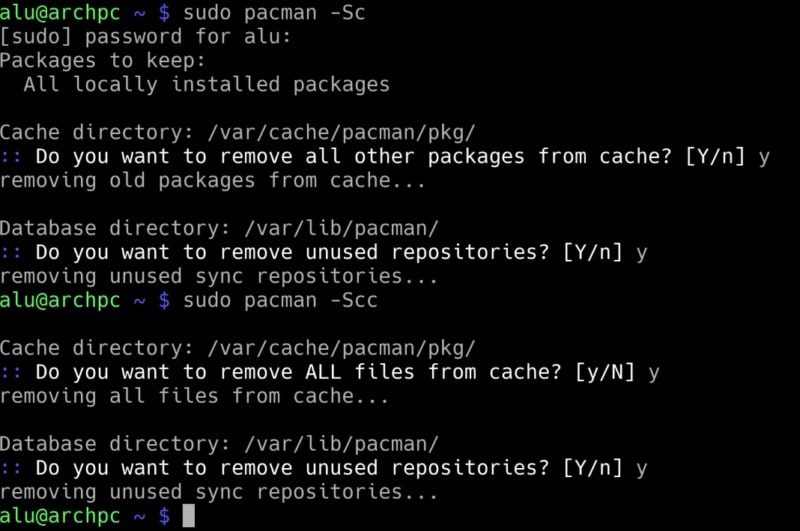
And if you happen to demand some of these packages after you removed them, you tin become to Curvation Package Annal and download them manually. This is not an optimal solution if you demand to download many packages because downloading them manually will have quite some time, but it is still possible.
Cleaning the cache Automatically
Another way to clean the /var/cache/pacman/pkg/ directory is to utilize a script that automatically deletes all cached versions of installed and uninstalled packages, except for the most recent iii versions. The script is called paccache. You can install information technology with the pacman-contrib package.
sudo pacman -S pacman-contrib For available, options cheque the assist card of paccache.
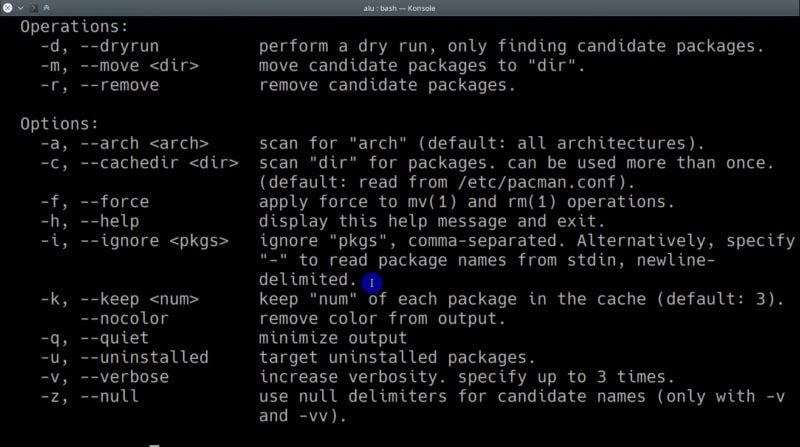
For case, you can run it in the dry mode to encounter how many packages will be removed using the -d selection. Then, you tin can run a real make clean by using the -r choice.

Run paccache monthly
A very useful way to use this script is to take it run automatically one time a calendar month using the systemd timer. Basically, you lot need to create the file paccache.timer in /etc/systemd/system/, which will trigger /usr/lib/systemd/system/paccache.service.
So, you create a paccache.timer file with nano:
sudo nano /etc/systemd/system/paccache.timer Then, to run this script monthly, paste the post-obit content into this file:
[Unit] Description=Clean-up erstwhile pacman pkg [Timer] OnCalendar=monthly Persistent=true [Install] WantedBy=multi-user.target Later that, offset the systemd service:
sudo systemctl enable paccache.timer sudo systemctl start paccache.timer Finally, yous tin check the service status.
sudo systemctl status paccache.timer 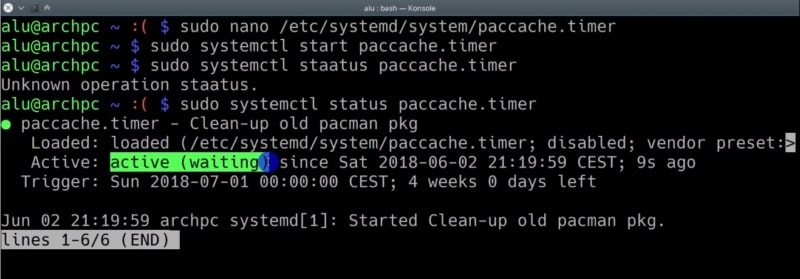
So, y'all should encounter the message that it is active. Now, paccache will run every month and make clean the cache of your one-time and uninstalled packages.
Run paccache later pacman
Alternatively to this timer, you tin also run paccache every time later you run pacman. So, you need to create a Hook for that. Simply create a file /usr/share/libalpm/hooks/paccache.hook.
sudo nano /usr/share/libalpm/hooks/paccache.hook After that, add together this content on the file.
[Trigger] Performance = Upgrade Operation = Install Functioning = Remove Type = Bundle Target = * [Activeness] Description = Cleaning pacman cache with paccache … When = PostTransaction Exec = /usr/bin/paccache -r At present, if I remove a package using pacman, paccache will also be executed.
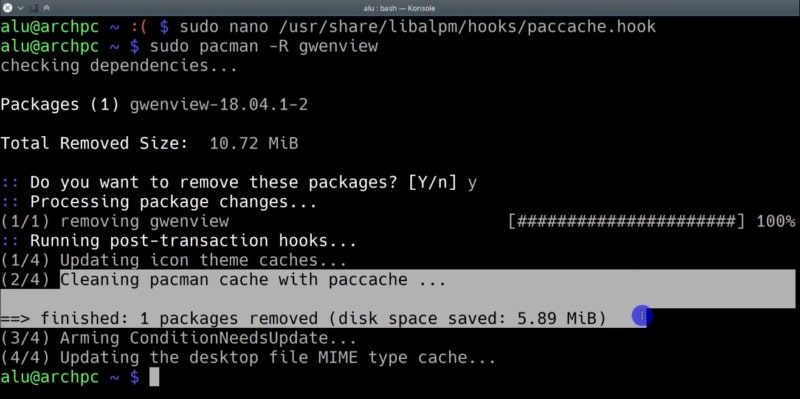
Did not you know this way to clean up Arch Linux?
2. Remove unused packages (orphans)
When you install and remove packages in Curvation Linux, some unused orphans packages may remain on your system. To detect them you need to run this command:
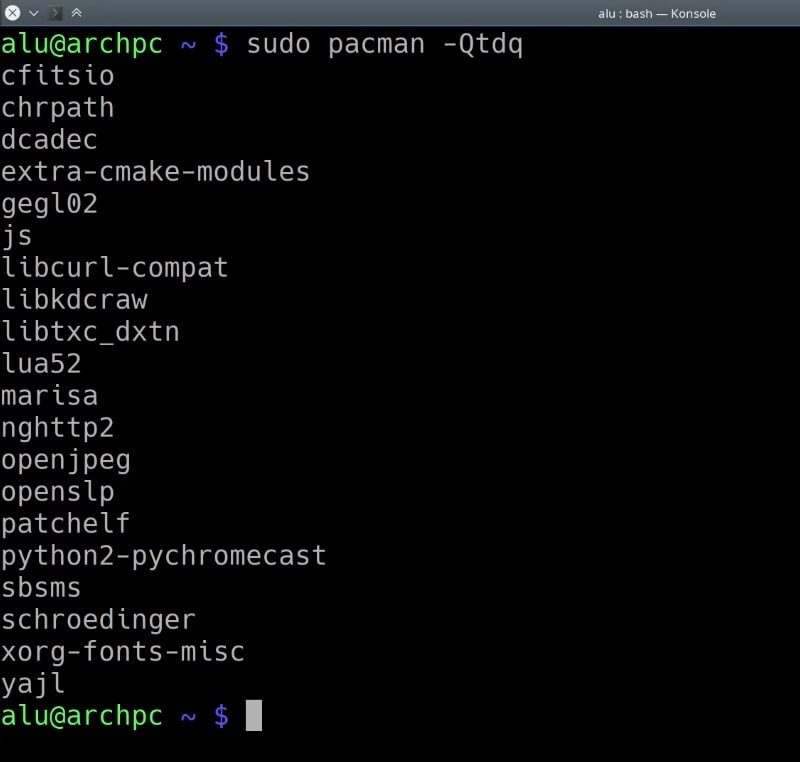
As you can see, by executing the higher up command, y'all will be able to know which packages are orphans. To remove them, you lot need to modify the command with the remove action:
sudo pacman -Rns $(pacman -Qtdq) 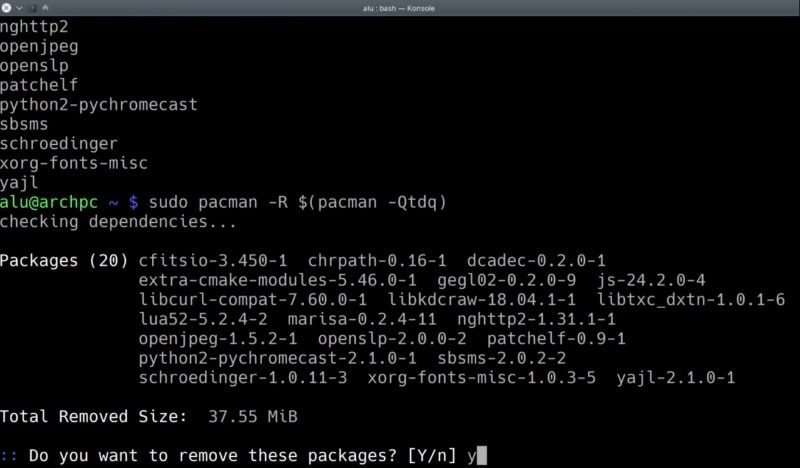
Now, you know how to make clean Arch Linux arrangement files by removing the pkg cache and removing the orphan packages. Nonetheless, in that location are still more than things to do in your abode folder.
3. Clean the enshroud in your /home directory
In this step, I will evidence y'all how to clean Curvation Linux by removing the cache files in your /dwelling/user folder.
As nosotros employ our system, the cache will make full up and take up a lot of infinite. So, the first thing you probably would want to exercise is to clean cache in your user directory. If you want to cheque the size of your cache binder, you lot can do it with this command:

To clean it, you lot need to remove all files inside it:
And that is information technology.
4. Remove old config files
The configuration files of unlike programs are stored in ~/.config/. You tin enter it from your file director and bank check if in that location any config files left from the programs y'all uninstalled. Just select those folders and delete them. Merely before you lot remove whatsoever file, I would too remind yous that it is amend to have a backup of all your files earlier you lot remove anything.
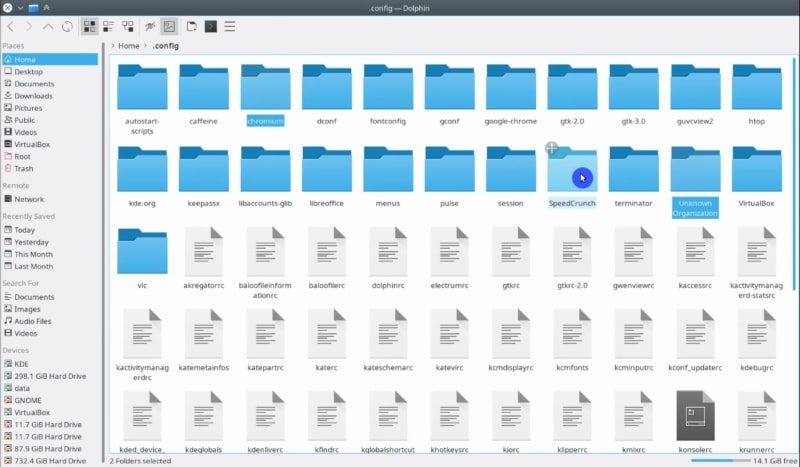
Some old files may likewise be lying in ~/.local/share/. Check it too and delete some files and folders if necessary.
five. Remove duplicates, empty files, empty directories and broken symlinks
You can do even more than cleaning by removing duplicated and empty files and directories. To go along some order in your organisation, I too recommend removing broken symlinks, e.i. links that atomic number 82 to non-existing filer or folders. They do not take much space, but they clutter your system. To remove such things, you can employ the program rmlint.
Install it:
If y'all bank check all its options with --aid, yous will see there are pretty many. I recommend to explore them.
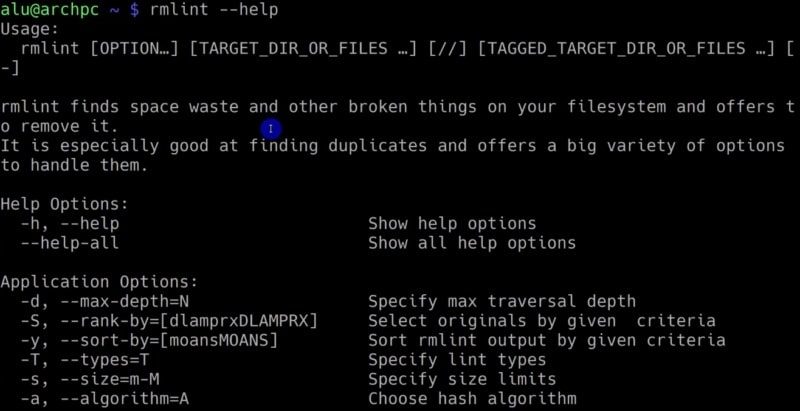
However, using this application is quite simple, yous can run information technology by specifying the directory yous desire to cheque for duplicated files. For case:
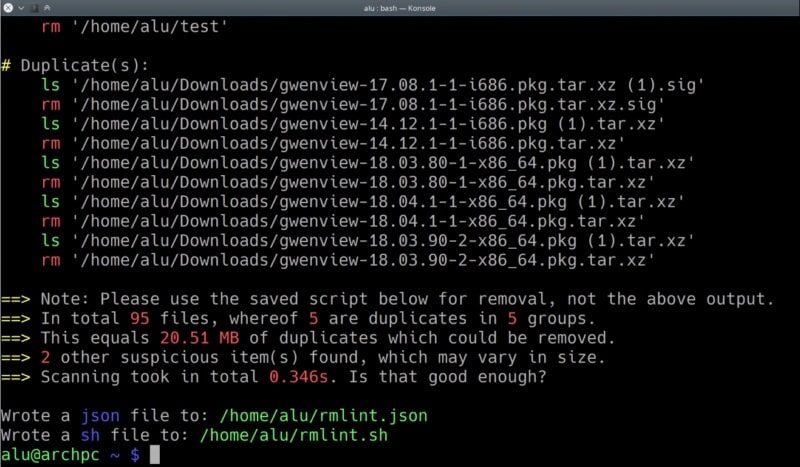
This program will list everything it finds and creates a shell script to remove this lint. The script tin can be found in the abode folder. Open up it using a text editor, curlicue downwards and check what files it will remove.
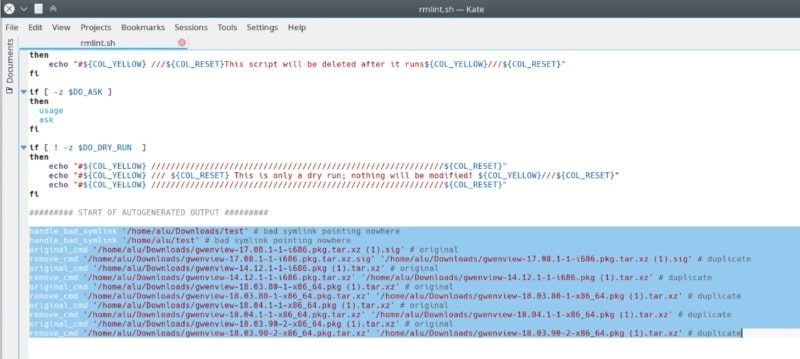
You can remove some of these files manually, or if you agree with suggested remove action you tin can go back to the final and execute this script. Again, brand sure you have a fill-in of all files earlier yous run this script. This action volition be irreversible.

At present, your organization is cleaner. But it is not the end, there are still a few things you tin can practise to make clean it even further.
half-dozen. Find the largest files and directories
Y'all can check what the largest files in your organization are and mayhap you do not need them. To achieve this chore, you lot can apply some control line tools or graphical programs. For the command line tool, I utilize ncdu.
To install it, run this control:
Search for the largest directories and then become within those directories and discover the largest files and remove them if you do not need them.

If you prefer a graphical program you can use filelight for Plasma 5. It shows a graphical summary for all hard-drives and y'all can go inside and check the directories, then get inside the largest directories and so on until.
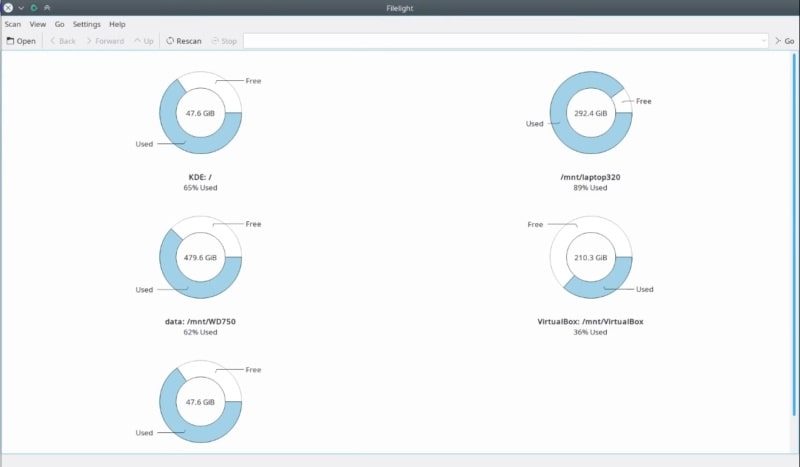
If you are using Gnome, you ca install baobab. In that location are another tools listed in Arch Wiki. Pick whatever yous similar.
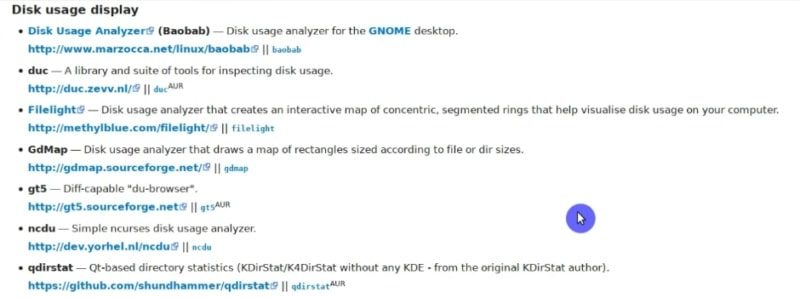
vii. Disk cleaning programs
There are also some disk cleaning programs that tin can practice many of the tasked listed above automatically. Withal, since you lot use Curvation Linux, I do not recommend using these programs. Information technology is not always obvious what exactly will exist done and yous do not have full control of your system. Besides, you can very easily delete some configuration files you did not want to delete.
But I still would similar to share with you lot this choice as some user may nonetheless prefer all-in-1 packet for system cleaning.

Amongst all automatic cleaning programs in Curvation Linux, Bleachbit is probably the well-nigh pop. It has a nice graphical interface and it can do near of the things I take shown higher up. For example, you can clean your system cache. Just select it, and click on the clean push.
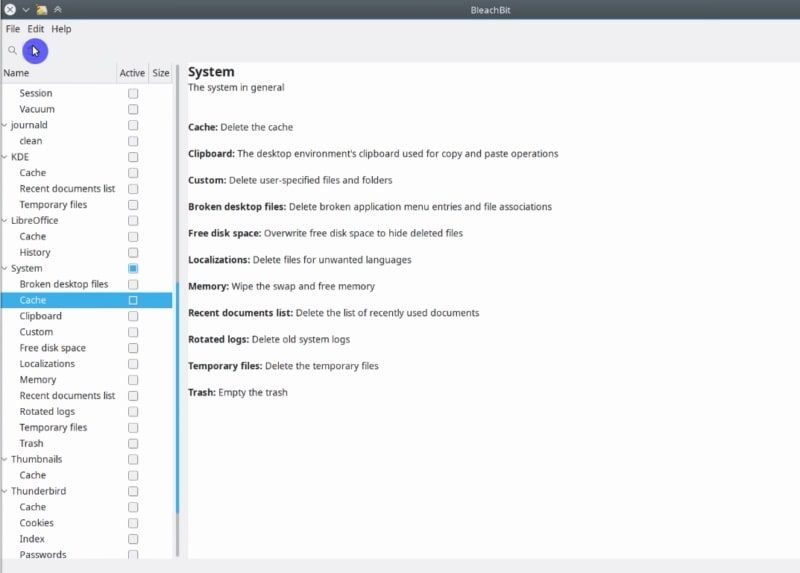
In the end, you volition see something like this.

Which ways your organisation cache has been cleaned.
Cheque out the other options of Bleachbit. I believe about of them are cocky-explanatory.
Update
Thank you to the comments on YouTube and below this post, I tin can improve this mail past extending this listing. Below, you will find a few more than things yous tin can exercise to clean your Curvation Linux organisation.
viii. Clean Systemd journal
Systemd stores its logs in /var/log/journal/ and these logs tin be very useful as I described in my post on 10 Things to exercise offset afterwards installing Arch Linux. However, these log files tin can take up to x% of your arrangement size by default. There are ii solution to limit this size.
- You lot can clean these log files manually when you run out of infinite. Yous can continue merely the latest logs by size limit (e.g. keep only 50Mb of the latest logs):
sudo journalctl --vacuum-size=50M Or past time limit (e.one thousand. last 4 weeks):
sudo journalctl --vacuum-fourth dimension=4weeks - You can also set such limit equally permanent and never worry near cleaning the logs. Only edit the file
/etc/systemd/journald.confby uncommentingSystemMaxUse=and setting the size limit:
This is what I cull to do and that is why I missed this bespeak when I originally wrote this article. I simply never experienced large journalctl files.
I would like to acknowledge Sebastian for pointing this out in the comments section.
CONCLUSION
At present that you lot know how to clean Curvation Linux, so there are no excuses not to practise it on your system :-) Remember that lack of complimentary infinite may boring downwardly your system, then in some sense, these things help to maintain a stable and fluid system.
Nevertheless, I cannot know everything. If at that place is something y'all would add, please comment below.
You may also similar my post nearly Install and configure Plasma 5 on Curvation Linux.
Source: https://averagelinuxuser.com/clean-arch-linux/
Posted by: longfusent.blogspot.com


0 Response to "How To Winterize Inground Paramount Floor Cleaning Lines With Shop Vac"
Post a Comment